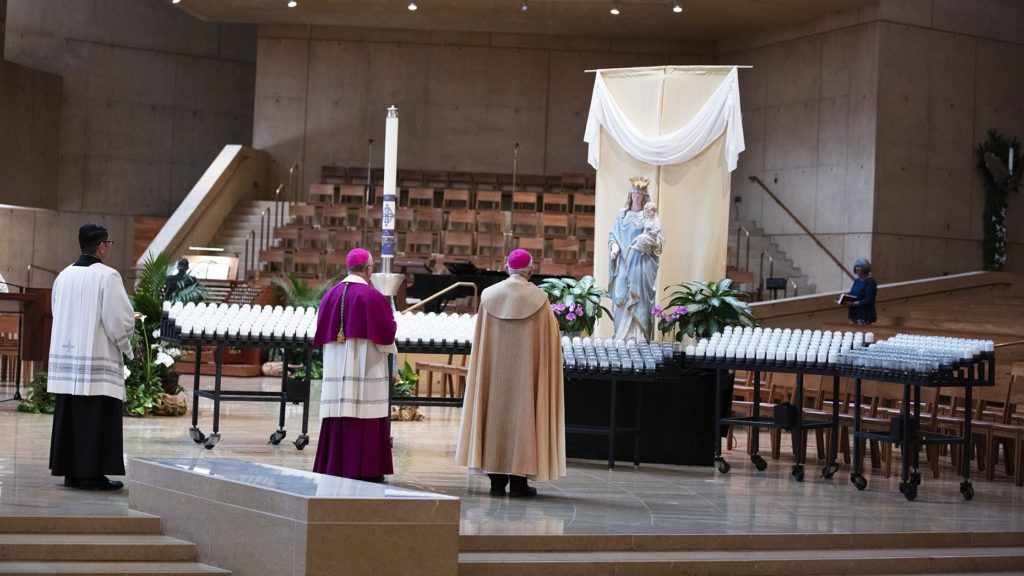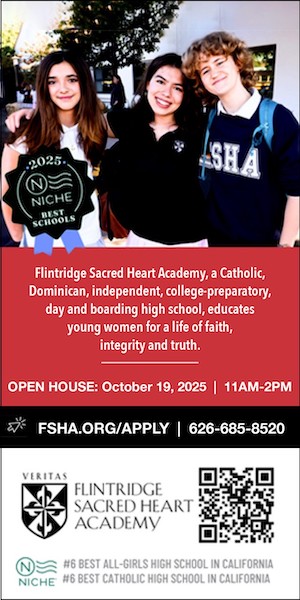"When I find myself in times of trouble, Mother Mary comes to me," sang Paul McCartney in the enduring 1970 Beatles' anthem, "Let It Be."
McCartney, who was baptized Catholic, said the lyric was inspired by a dream appearance of his biological mother. But many listeners -- given the hymn-like organ chords in the tune -- instead assumed a reference to the Blessed Virgin Mary.
Indeed, "in times of trouble" it's only natural for Catholics to resort to petitioning their own Mother Mary. And five years ago -- on May 1, 2020, during the first terrifying stages of the COVID-19 pandemic -- the bishops of the United States did just that.
Archbishop José H. Gomez of Los Angeles, then president of the U.S. Conference of Catholic Bishops, led a "Renewal of the Consecration of the United States of America to the Blessed Virgin Mary" at LA's Our Lady of the Angels Cathedral. The ceremony -- lasting just a little more than 30 minutes -- was livestreamed to isolated viewers across the country.
By April 2020, more than 3.9 billion people -- almost half of the world's population -- were in lockdown quarantine. The United States was particularly hard hit among Western industrialized nations, posting an eventual 111,820,082 coronavirus cases and 1,221,897 deaths.
"In this difficult time we turn to the Blessed Virgin Mary, mother of the church. She intercedes with her Son for all are affected in this way by the pandemic," intoned Archbishop Gomez. "We implore her maternal care for her children."
"The first missionaries came to this country under the mantle of Our Lady of Guadalupe. Later, the bishops consecrated her as patroness of the United States of America," he added, emphasizing the country's Marian heritage. "The Virgin Mary has accompanied this great nation since our beginnings," he added. "Now in this difficult hour, we renew our consecration to her."
America had previously been dedicated to Mary on three occasions.
In 1792, Bishop John Carroll, the first bishop of the U.S., consecrated the country to Mary under the title of the Immaculate Conception. In 1846, the U.S. bishops -- then numbering 23 -- did the same, choosing her as America's patroness. In 1959, Cardinal Patrick O'Boyle of Washington consecrated America to the Immaculate Heart of Mary, to coincide with the completion of the National Shrine of the Immaculate Conception. (In 1990, St. John Paul II elevated the shrine to minor basilica status.)
"Five years ago, the late Holy Father invited us to turn to Our Lady and implore her to watch over the world during the COVID pandemic," said Msgr. Walter Rossi, rector of the national shrine in Washington, America's preeminent Marian shrine and the largest Roman Catholic Church in North America.
"Pope Francis did the same in 2022 petitioning the Blessed Mother for peace especially for Ukraine and Russia. As children run to their mother in times of crisis, emergency and joy, so, we should turn to Our Heavenly Mother at all times," Msgr. Rossi added, "confident that in the words of the ancient prayer, Sub Tuum Praesidium, Our Lady will ‘deliver us from all dangers.'"
Such recourse to the Blessed Mother is not without historical precedent. Whether in time of disease, war or distress, the faithful have routinely communally petitioned her.
When a devastating plague broke out in Rome during the reign of St. Gregory the Great -- who was pope from 590-604 -- the pontiff carried an ancient icon of Mary holding the infant Jesus throughout Rome in solemn procession. After the plague ceased, the icon -- known as "Salus Populi Romani" (Protectress of the Roman people) -- was ensconced in the Basilica of St. Mary Major, where Pope Francis has been buried. During his own pontificate, Francis habitually visited it to pray, a total of 126 times.
At the dawn of the coronavirus pandemic, Pope Francis had Salus Populi Romani brought to St. Peter's Basilica. As he prayed in an empty, rain-soaked St. Peter's Square on March 27, 2020, he said during his prayer, "We know that you can take care of us."
Father Edward Looney, secretary of the Mariological Society of America, noted, "Time and again, people have made some sort of active entrustment or consecration to Our Lady in times of crises, and we usually see a favorable outcome afterwards."
"Pope Francis had a prayer against the coronavirus pandemic, and it was directly addressed to Our Lady: ‘Oh Mary, you shine continuously on our journey as a sign of salvation and hope; you are the health of the sick," Father Looney recalled. "The church throughout the world was really asking Our Lady for her intercession during the pandemic. And so I think when the U.S. reconsecrated itself to Our Lady, this was just kind of an extension of that global prayer in a sense."
Mariologist Mark Miravalle, a professor of theology at the Franciscan University of Steubenville in Ohio, suggested that the consecration actually limited the deadly effects of the virus.
"I am quite confident that the consecration that was done by the U.S. and some other episcopal conferences, in fact, led to the saving of lives," said Miravalle.
"I think it also led to great graces in having people be able to deal with the kind of historic challenges that came with COVID, not only in terms of sickness -- but emotional, financial, psychological, and certainly spiritual, because of the great challenge this manifested to so many. And so on the same principle that personal consecration to Our Lady is so valuable," Miravalle added, "I think there's clearly direct supernatural fruits to the bishops calling on the mother of Jesus at that time of difficulty."

